
Original Link: https://www.anandtech.com/show/1018
AOpen has been in the motherboard market for a while, and is currently trying to break back into the high-end and enthusiast markets with their latest incarnation, the AOpen AX4PE Max.
As you're about to see, AOpen has put together a very well-balanced motherboard that's able to provide a girth of features, performance, and some fairly nice tweaking options.
The competition is pretty stiff, but AOpen is able to produce quite a good piece of hardware…
|
Motherboard Specifications |
|
|
CPU
Interface
|
Socket-478
|
|
Chipset
|
Intel
82845PE MCH
Intel 82801DB ICH |
|
Bus
Speeds
|
100
- 248MHz (in 1MHz increments)
|
|
Core
Voltages Supported
|
up
to 1.85V (in 0.025V increments)
|
|
I/O
Voltages Supported
|
N/A
|
|
DRAM
Voltages Supported
|
up
to 2.65V in 0.05V increments
|
|
Memory
Slots
|
3
184-pin DDR DIMM Slots
|
|
Expansion
Slots
|
1
AGP 4X Slot
6 PCI Slots |
|
Onboard
RAID
|
Promise
PDC20375 Serial ATA RAID
|
|
Onboard
USB 2.0/IEEE-1394
|
USB 2.0 Supported through South Bridge, TI TSB43AB22 FireWire Controller
|
|
Onboard
LAN
|
Realtek
8100B 10/100 LAN
|
|
Onboard
Audio
|
Realtek
ALC650 6-channel audio
|
|
Onboard
Serial ATA
|
See
Onboard RAID
|
|
BIOS
Revision
|
R1.00a
(10/2/2002)
|
AOpen AX4PE Max: Basic Features
AOpen's 845PE board offers some very similar features as those found on the recently reviewed ASUS P4PE and Epox 4PEA+ motherboards.
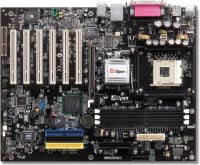
AOpen doesn't include anything too fancy in the way of LAN or sound chips. Realtek has clearly taken a commanding lead when it comes to onboard features like sound and LAN, and the AOpen AX4PE Max continues this trend. Onboard LAN is powered by Realtek's 8100BL chip.
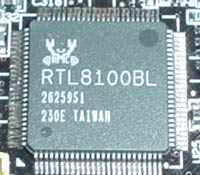 |
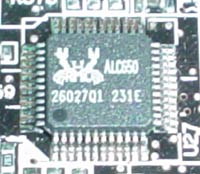 |
Moving on we see that the onboard sound is powered by Realtek's ALC650 chip. This is exactly the same sound chip found on Albatron's 845PE motherboard (the PX845PEV Pro) as well as Epox's 845PE motherboard, the 4PEA+.
The I/O configuration included with the AOpen AX4PE Max isn't too bad either. There are two PS/2 ports, two serial ports, one parallel port, four rear USB 2.0 ports, a LAN port, a Game Port, Mic In, Line In, and Line Out that is driven by the onboard sound.
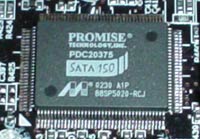
 AOpen
looks ahead to the future by offering Serial ATA RAID capability through the
Promise PDC20275 controller. This controller is capable of supporting up to
two independent Serial ATA devices, similar to the Silicon Image 3112 controller.
As with basically all the RAID chips on the market, this RAID chip offers RAID
0 (striping) and RAID 1 (mirroring) array capability.
AOpen
looks ahead to the future by offering Serial ATA RAID capability through the
Promise PDC20275 controller. This controller is capable of supporting up to
two independent Serial ATA devices, similar to the Silicon Image 3112 controller.
As with basically all the RAID chips on the market, this RAID chip offers RAID
0 (striping) and RAID 1 (mirroring) array capability.
There's also one additional IDE connector (besides the Primary and Secondary IDE connectors that are capable of providing two channels per connector). This connectors adds another two possible drives to your system, which in total gives you up to six IDE drives you can hook up to this system, which is very nice.
As is pretty normal with most 845PE boards, AOpen doesn't include an additional onboard USB 2.0 controller, but instead simply uses the native USB 2.0 support located in the ICH4 South Bridge, which offers support for up to six USB 2.0 ports. Only the Gigabyte 8PE667 Ultra offers more possible USB 2.0 ports (a total of ten) among the 845PE motherboards we've tested. Additionally though, AOpen is good enough to include FireWire support. FireWire is powered by TI's TSB43AB22 controller, which supports up to two FireWire ports.
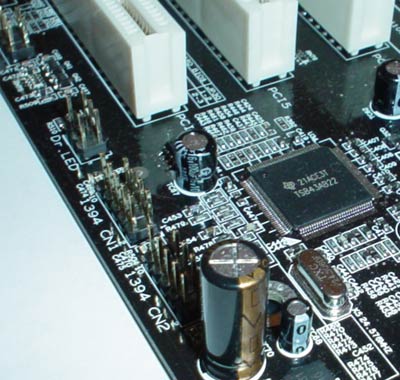
There are two FireWire headers positioned at the bottom of the motherboard that allows you to take advantage of the onboard TI FireWire controller.
AOpen AX4PE Max: Board Layout
The AOpen AX4PE Max was laid out fairly well, although there were a couple of items placed in some not-so ideal positions.
We were pretty pleased to see the ATX connector placed on the ideal side of the AX4PE Max. As you can plainly see, the ATX connector is located on the right-hand side of the motherboard, to the right of the DIMM slots. This positioning is only decent, as the ATX connector seems to be a bit too low; ideally, it would be placed higher up on the right-hand side of the motherboard, perhaps just above the DIMM slots. The ATX12V connector is located on the left-hand side of the motherboard, right next to the I/O ports. This is unfortunate, as you have to unhook the ATX12V line to uninstall your HSF, which is an additional annoyance. But because we almost always see motherboard makers position their ATX12V connectors this way, we can't blame AOpen too much. It's an unfortunate reality.
One of the major layout problems with this motherboard is the location of the Primary and Secondary IDE connectors. Both connectors were located below the installed GeForce4 Ti4600 video card we used. This isn't the optimal location for the Primary/Secondary IDE connectors because it makes it increasingly difficult to reach the upper most drive bays of a full-sized ATX computer case. If both connectors were placed above our video card, we wouldn't have to worry about the IDE cables being able to reach high enough in a full-sized ATX case, nor would we have to worry about the IDE cables getting tangled up with the video card, further causing clutter.
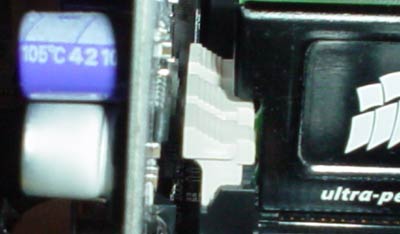
The AOpen AX4PE Max's DIMM connectors aren't located far enough away from our GeForce4 Ti4600 unfortunately. We see in the above picture that the connectors are simply much too close to the video card for us to be able to uninstall our memory without forcing us to first uninstall the video card. This is quite the annoyance, and somewhat common with 845PE motherboards.
The rest of the AOpen AX4PE Max's layout is pretty good in general though. There are two FireWire headers located at the very bottom of the motherboard just to the right of the last PCI slot. This is the optimal position to place the FireWire headers because the wires from your FireWire brackets won't get tangled up too badly with other PCI cards that you may install.
Unfortunately, the USB 2.0 header is located higher up on the motherboard, closer to the middle portion of the PCI slots. This location tends to clutter the center of your case and restrict air flow due to the thick USB cables. We obviously would have preferred to have seen this USB header located next to the FireWire headers.
AOpen AX4PE Max: BIOS and Overclocking
As is very common among most modern-day motherboards, the AOpen AX4PE Max utilizes the Award BIOS.
 |
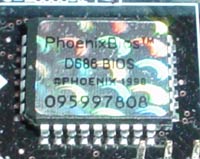 |
The PC Health section of the AOpen AX4PE Max contains a fairly
good amount of information. Here you'll find readings on CPU temperature,
system temperature, CPU other fan header speeds, Vcore, and PSU readings (all
rails). There's also an option for enabling CPU warning temperature if so
desired.
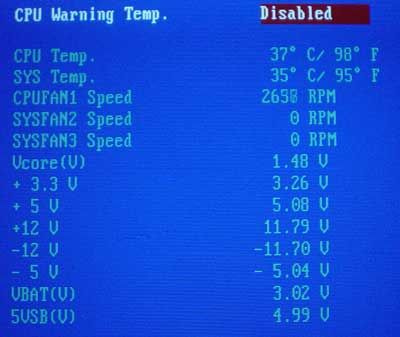
The AX4PE Max contained some fairly common DRAM tweaking options in the Advanced Chipset Features section. You're able to adjust CAS Latency, Precharge to Active, Active to Precharge, and Active to CMD. Unfortunately there were no Command Rate, Bank Interleave, or DRAM timing mode options available, but that's becoming more common with 845PE boards nowadays.
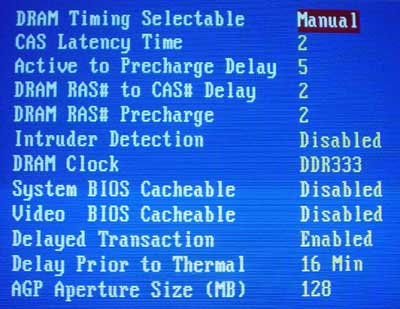
In addition, we see some good FSB adjustments available in the BIOS. The FSB is adjustable all the way up to 248MHz, which is plenty for most overclockers. One of the biggest downsides to this motherboard is the lack of any available memory adjustment options. There are 1:1 and 4:5 ratios available, but they are locked at DDR266 and DDR333 no matter the FSB value. This is unfortunate, as we would have liked to have seen how well this board overclocked with memory running at 400MHz with one, two and three DIMMs installed.
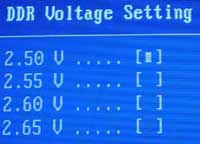 |
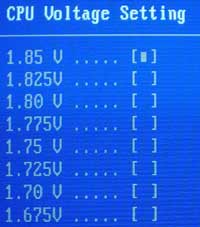 |
The voltage tweaking options are only mediocre with this motherboard. The highest available VDIMM you can achieve is 2.65V in .05V increments. While not too bad, memory overclockers will probably not be too happy, even though overvolting memory doesn't yield too much better of a memory overclock to begin with. VAGP is also pretty weak, since it's only adjustable as high as 1.6V. This will disappoint a few video card overclockers for sure, but like VDIMM and memory, it's not all that necessary to raise VAGP to get a good video card overclock.
One of the better voltage tweaking options you're able to play with is Vcore, which is adjustable all the way up to 1.85V in .025V increments. In reality, default Vcore runs between 1.48-1.50V, so you'll "only" able to go as high as 1.84V or so. 1.84Vcore is much too high for conventional air cooling though, so this is not a setback at all.

So far, every 845PE-based motherboard we've tested has come with an independent AGP/PCI lock. As was expected, the AOpen AX4PE Max utilized an AGP/PCI lock at 66MHz/33MHz. Interestingly enough, AOpen lets you adjust the AGP and PCI buses independently of each other, while still maintaining the AGP/PCI lock feature. For example, at default values, our system would be running 133MHz FSB / 66MHz AGP / 33MHz PCI. If we decided to overclock the FSB, we would be able to run 161MHz FSB / 66MHz AGP / 33MHz PCI. What AOpen lets you do differently than any other board however is run at, for example, 161MHz FSB / 75MHz AGP / 33MHz PCI or 161MHz FSB / 66MHz AGP / 40MHz PCI. Of course, you don't usually want to run your AGP or PCI cards too far out of their default frequencies anyway, so this should be a moot point for most. Still, it's an interesting feature to have.
Not surprisingly, the AOpen AX4PE Max maintained a pretty average overclock
in comparison to all the other 845PE boards we've tested here at AnandTech.
The following table lists the components we used for overclocking the FSB using
the AOpen AX4PE Max motherboard:
|
Front Side Bus Overclocking Testbed |
|
|
Processor:
|
Pentium
4 2.26GHz
|
|
CPU
Vcore:
|
1.5V
(actual)
|
|
Cooling:
|
Intel
Retail HSF & Thermal Pad
|
|
Power
Supply:
|
Enermax
300W
|
With this very conservative overclocking setup we were able to reach 161MHz FSB, or a 2.74GHz core clock speed. With a little extra voltage (bumped up to 1.55V), we were able to hit 164MHz FSB reliably.
As we've mentioned in the past, this type of overclock isn't unusual for an 845PE-based motherboard (or any board based on an 845 chipset for that matter). We've tested many SiS 648 motherboards here at AnandTech (including ones we haven't shown you yet), and the average overclock still seems to hover between only 143MHz-150MHz. Our 845PE motherboards have all hovered between 160MHz-166MHz using the exact same FSB Overclocking Testbed as the SiS boards (same exact processor, CPU Vcore, Cooling, and Power Supply). Our results speak for themselves; Intel chipset-based motherboards are the only way to go if you're an extreme overclocker.
Unfortunately, we were unable to conduct any type of memory overclocking with the AOpen AX4PE Max because of the limited ratio options available. But even though the AX4PE Max has very limited memory control options, this board was still able to put up some good DDR333 performance and stress test numbers, so read on.
AOpen AX4PE Max: Stress Testing
Due to the limited amount of stress testing potential with the AOpen AX4PE Max, we were only able to run a handful of stress tests on this motherboard. But we still managed to test this board in several different areas and configurations, including:
1. Chipset and motherboard stress testing was conducted by running the FSB at 161MHz.
2. Memory stress testing was conducted by running RAM at 333MHz with one bank filled as well as as many as was possible from that point on with the most aggressive timings possible.
During the FSB stress tests, the AOpen AX4PE Max was able to withstand a number of tests running at 161MHz FSB (645MHz quad pumped FSB). At this overclocked speed, the AOpen AX4PE Max was capable of running Prime95 torture tests for exactly 24 hours. As we usually do, we reran our entire benchmark suite several times over at this FSB speed to check for any other possible instability. The AX4PE Max seamlessly completed all our stress tests successfully at 161MHz FSB using our standard overclocking testbed.
The AOpen AX4PE Max had very limited memory options, so we were only able to run some fairly conservative memory stress tests. Here were our results in a conservative DDR333 situation; one installed Corsair DIMM running at 333MHz with the most aggressive timings possible:
|
Stable
DDR333 Timings |
|
|
Clock
Speed:
|
166MHz
|
|
Timing
Mode:
|
N/A
|
|
CAS
Latency:
|
2
|
|
Bank
Interleave:
|
N/A
|
|
Precharge
to Active:
|
2T
|
|
Active
to Precharge:
|
5T
|
|
Active
to CMD:
|
2T
|
|
Command
Rate:
|
N/A
|
Of course, these are the best settings you can achieve in the
Advanced Chipset Features section of the AX4PE Max's BIOS. You will obviously
have to be running some high quality memory to achieve these timings, although
it shouldn't be too difficult considering there is only one DIMM installed in
this scenario.
After completing a very simple DDR333 run with one DIMM installed, we moved on to the most strenuous situation possible at stock memory speeds, which was all banks filled with memory running at 333MHz. We were able to achieve the following DRAM settings with all banks filled:
|
Stable
DDR333 Timings |
|
|
Clock
Speed:
|
166MHz
|
|
Timing
Mode:
|
N/A
|
|
CAS
Latency:
|
2
|
|
Bank
Interleave:
|
N/A
|
|
Precharge
to Active:
|
2T
|
|
Active
to Precharge:
|
5T
|
|
Active
to CMD:
|
2T
|
|
Command
Rate:
|
N/A
|
These are the best DDR333 timing possible via the Award BIOS of the AOpen AX4PE Max. Obviously the most impressive aspect of this type of memory performance is the fact that it's able to run at these settings with all banks filled with memory. It's worth noting that we did not have to back off of the timings in order to utilize all three memory banks, a big plus in our book.
As you are already aware of, we couldn't run memory at 400MHz because of the extremely limited memory options available in the BIOS, which didn't allow us to overclock memory whatsoever. However, that didn't stop us from running stress tests in the toughest memory situation possible with this particular motherboard. To ensure all these memory settings were stable, we ran Prime95 torture tests around the clock (all timings ended up being CAS 2-2-2-5). The AOpen AX4PE Max was able to sustain 24 hours of Prime95 torture tests, which was certainly very impressive. In fact, the AX4PE Max was able to do this while the FSB was clocked at 161MHz, which is even more impressive. Our Super Pi tests didn't disappoint us either, as the AX4PE Max ran right through the most strenuous Super Pi settings.
For this particular 845PE motherboard, we decided to install multiple types of memory from different manufacturers. Samsung, Kingston, Twinmos, Mushkin, and Corsair memory were all tested at the frequency of 333MHz on the AOpen AX4PE Max. Due to the massive amount of different memory modules used, we were only able to run Prime95 for several hours at a time. Still, we're happy to report that after multiple hours of testing, all memory modules passed our Prime95 torture tests.
Looking at our memory stress testing results, it's clear that the AOpen AX4PE Max is a solid DDR333 motherboard.
AOpen AX4PE Max: Tech Support and RMA
For your reference, we will repost our tech support evaluation procedure here:
The way our Tech Support evaluation works is first we anonymously email the manufacturer's tech support address(es), obviously not using our AnandTech mail server to avoid any sort of preferential treatment. Our emails (we can and will send more than one just to make sure we're not getting the staff on an "off" day) all contain fixable problems that we've had with our motherboard. We then give the manufacturer up to 72 hours to respond over business days and will report not only whether they even responded within the time allotted but also if they were successful in fixing our problems. If we do eventually receive a response after the review is published, we will go back and amend the review with the total time it took for the manufacturer to respond to our requests.
The idea here is to encourage manufacturers to improve their technical support as well as provide new criteria to base your motherboard purchasing decisions upon; with motherboards looking more and more alike every day, we have to help separate the boys from the men in as many ways as possible. As usual, we're interested in your feedback on this and other parts of our reviews so please do email us with your comments.
AOpen's technical support process is very straight forward and clear. In fact, it's one of the best we've encountered.
Here's how it works. Once you've found the Problem Reports page on AOpen's web site, you click on the hyperlink that refers to the country and/or language that applies to you. AOpen includes the following countries and languages:
English (Canada, USA, and Latin America).
English (Europe)
English (Asia & other regions)
Chinese
China
Japanese
German
After clicking the first hyperlink, we were taken to the AOpen American Technical Support Center page. Here we were asked to fill out a detailed form (similar to Epox's and Gigabyte's technical support forms) where we were asked for our personal information (including name, address, phone number, etc.), the product in question, the model/serial/part number, system specifications (CPU, Operating System, BIOS version, etc.), and of course an area for describing the problem in detail. AOpen even listed examples under each category in case a user was unaware of what to type in (for example, under the "CPU type/speed" category, AOpen listed "Pentium II 266" as an example of a CPU).
AOpen's technical support response was equally impressive. We received a response from their tech support staff exactly 23 hours after we sent our email. AOpen was also able to correctly diagnose our "problem", which is a big plus.
The following is AOpen's RMA policy in its entirety:
|
AOpen's RMA procedure isn't too bad, but like a lot of the other motherboard manufacturers AOpen asks end users to first consult with the vendor you purchased your AOpen motherboard from before requesting an RMA directly from AOpen. AOpen makes this very clear on their RMA pages. This seems to be the average RMA policy with most motherboard makers, so we're not too disappointed.
While AOpen's RMA policy is only average, their outstanding technical support response time and organization are redeeming factors of the customer support AOpen provides.
The Test
|
Performance Test Configuration |
||
| Processor(s): |
Intel
Pentium 4 2.26GHz
|
|
| RAM: |
256MB Samsung DDR333 CAS2.5 Modules
256MB Kingston DDR333 CAS2.5 Modules 256MB Twinmos DDR400 CAS2.5 Modules 256MB Mushkin DDR400 CAS2.5 Modules 256MB Corsair DDR400 CAS2.0 Modules |
|
| Hard Drive(s): |
Western Digital 120GB 7200 RPM
Special Edition (8MB Buffer)
|
|
| Bus Master Drivers: |
Intel Application Accelerator
v2.2.2
SiS Chipset Patches |
|
| Video Card(s): |
ASUS
V8460 Ultra NVIDIA GeForce4 Ti 4600
|
|
| Video Drivers: |
NVIDIA
Detonator 30.82
|
|
| Operation System(s): |
Windows
XP Professional
|
|
| Motherboards: |
Albatron
PX845PEV Pro (845PE)
AOpen AX4PE Max (845PE) ASUS P4B533-E (845E) ASUS P4B533-V (845G) ASUS P4PE (845PE) ASUS P4GE-V (845GE) ASUS P4T533-C (850E) Epox 4PEA+ (845PE) Gigabyte 8PE667 Ultra (845PE) Gigabyte 8SG667 (SiS 648) Intel D845PEBT2 (845PE) |
|
All performance tests were run using a 256MB Corsair XMS DDR400 module set to CAS 2-2-2-5 timings. Any other performance-enhancing timings (like Command Rate or Bank Interleave) were enabled in motherboards that contained such timings.
The AnandTech Motherboard Testbed was Sponsored by Newegg. You can buy the components we used to test at www.newegg.com.
Content Creation & General Usage Performance
For our Content Creation & General Usage performance we continue to use SYSMark 2002. The applications benchmarked include:
· Internet Content Generation: Adobe Photoshop® 6.01, Adobe Premiere® 6.0, Microsoft Windows Media Encoder 7.1, Macromedia Dreamweaver 4, and Macromedia Flash 5
· Office Productivity: Microsoft Word 2002, Microsoft Excel 2002, Microsoft PowerPoint 2002, Microsoft Outlook 2002, Microsoft Access 2002, Netscape Communicator® 6.0, Dragon NaturallySpeaking Preferred v.5, WinZip 8.0, and McAfee VirusScan 5.13.
For more information on the methodology and exactly what SYSMark does to generate these performance scores check out BAPCo's SYSMark 2002 Whitepaper.
|
|
Gaming Performance
|
|
Gaming Performance (continued...)
|
|
High End Workstation Performance - SPEC Viewperf 7.0
The latest version of SPEC Viewperf proves to be an excellent stress test for memory bandwidth and overall platform performance as you're about to see. The benchmarks included version 7 of the benchmark suite are:
3ds max (3dsmax-01)
Unigraphics (ugs-01)
Pro/Engineer (proe-01)
DesignReview (drv-08)
Data Explorer (dx-07)
Lightscape (light-05)
For more information on the tests run visit SPEC's page on the new Viewperf benchmark.
|
|
|
High-End Workstation Performance (continued...)
|
|
|
Final Words
AOpen has engineered quite a nice 845PE motherboard. There's certainly enough competition in the 845PE market that would make it difficult for any 845PE motherboard to really stand out, but we can say AOpen has done a pretty good job regardless.
For those looking for a feature-filled motherboard, the AOpen AX4PE Max easily fits the bill; it comes with FireWire, USB 2.0, Serial ATA RAID, sound, LAN, and room for future expansion. This whole package is expected to debut for just $145 or so in the next couple of weeks. For this price, there isn't too much to complain about.
However, for tweakers, this isn't the best 845PE motherboard available, although not too bad in general. The AOpen AX4PE Max contains somewhat weak voltage tweaking options such as a VDIMM max of just 2.65V and a VAGP ceiling of 1.6V. However, Vcore is adjustable as high as 1.85V. There's plenty of FSB room available as well, with an option for as high as 248MHz FSB. As our overclocking results proved, this board is good for overclockers too, but again it's nothing we haven't seen from the other 845PE motherboards.
All in all AOpen has done a great job with AX4PE Max. However, it will have a tough time competing with other 845PE solutions in certain segments. In the enthusiast segment for example, Epox's 4PEA+ brings a bit more to the table than the AOpen AX4PE Max is able to provide, and at an expected debut price of $140 to boot. In addition, AOpen will have an even tougher time competing against Intel's D845PEBT2 in the high-end OEM segment, yet another 845PE board expected to debut at $140.







